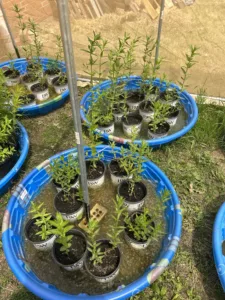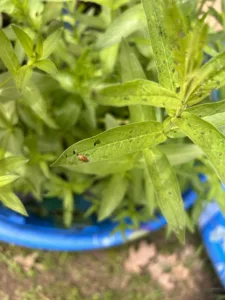Raising Purple Loosestrife Beetles
Northern Wisconsin is home to diverse ecosystems and natural landscapes that require conservation efforts to maintain their ecological balance. One of the challenges faced in this region is the invasion of non-native plant species, such as purple loosestrife (Lythrum salicaria). This aggressive plant has the potential to disrupt native habitats and reduce biodiversity. However, implementing biological control methods, such as raising purple loosestrife beetles (Galerucella spp.), offers a promising solution to manage this invasive species while minimizing environmental impact.
Understanding the Threat of Purple Loosestrife
Purple loosestrife is a perennial herbaceous plant native to Europe and Asia. It was introduced to North America in the 1800s and has since become a pervasive invasive species, particularly in wetland ecosystems.
 Purple Loosestrife Plants, Forest County Courthouse Square
Purple Loosestrife Plants, Forest County Courthouse Square
Biological Control with Purple Loosestrife Beetles
One of the most effective and environmentally friendly approaches to controlling purple loosestrife is through the introduction of beetles from the Galerucella genus.
Raising Purple Loosestrife Beetles
Understanding the lifecycle of purple loosestrife beetles is crucial to their successful propagation. The beetles undergo four stages: egg, larva, pupa, and adult. Eggs are laid on the undersides of purple loosestrife leaves, and upon hatching, the larvae begin feeding on the plant’s foliage. Pupation occurs on the stem or in the soil, and adult beetles emerge and continue to feed on purple loosestrife.
Purple Loosestrife Beetle, Courthouse Square
Collection and Release
To establish a beetle population, adult beetles can be collected from areas where they are abundant or obtained from specialized suppliers. Care must be taken to ensure the beetles are not carrying any diseases or parasites. After collection, the beetles are released strategically in areas with purple loosestrife infestations, allowing them to disperse and feed on the invasive plants.
Benefits of Raising Purple Loosestrife Beetles
- Environmentally Friendly: Raising purple loosestrife beetles offers a sustainable and ecologically sound alternative to chemical herbicides. It reduces the use of harmful chemicals and minimizes the risk of collateral damage to non-target organisms.
- Cost-Effective: In the long run, biological control methods tend to be more cost-effective than repeated herbicide applications. Once established, the beetle population can persist and continue to suppress purple loosestrife without significant ongoing investment.
- Preserving Native Biodiversity: By controlling purple loosestrife populations, the raised beetles help restore native plant diversity and promote the re-establishment of indigenous species. This, in turn, benefits wildlife by providing suitable habitats and food sources.
Raising purple loosestrife beetles provides a sustainable and effective means of controlling the invasive plant species in northern Wisconsin. Through careful collection, release, and monitoring, the beetle populations can be established and maintained, offering long-term benefits for the region’s ecosystems. Embracing biological control methods encourages the preservation of native biodiversity while minimizing environmental impacts. By actively participating in these efforts, residents and conservation organizations can contribute to the restoration and protection of northern Wisconsin’s natural habitats.
For more information contact Steve Kircher, County Conservationist-Land Information/GIS Director at 715-478-1387 or by e-mail at .
Conservation Corner is a weekly article produced by the Forest County Land & Water Conservation Department. For more information contact Steve Kircher, County Conservationist-Land Information/GIS Director at 715-478-1387 or by e-mail at .

